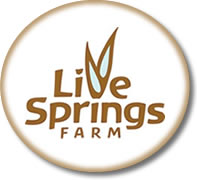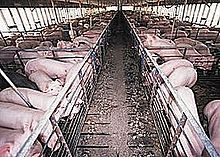 For more than one year, I’ve been on a quest to eat healthier and ethically (eating food that is sustainable and that helps rebuild the land, as well as eating meat that is humanely raised). With the help of my CSA, I found Live Springs Farm of Carrollton, Illinois, which is “dedicated to promoting sustainable, local, biodynamic agriculture; helping revive rural landscapes and economies; treating the livestock humanely; and producing healthy, wholesome food.” It’s currently producing and selling organic grain, hay, and legumes, as well as pastured pork and pastured poultry, where the animals are fed on natural diets in the pasture.
For more than one year, I’ve been on a quest to eat healthier and ethically (eating food that is sustainable and that helps rebuild the land, as well as eating meat that is humanely raised). With the help of my CSA, I found Live Springs Farm of Carrollton, Illinois, which is “dedicated to promoting sustainable, local, biodynamic agriculture; helping revive rural landscapes and economies; treating the livestock humanely; and producing healthy, wholesome food.” It’s currently producing and selling organic grain, hay, and legumes, as well as pastured pork and pastured poultry, where the animals are fed on natural diets in the pasture.
Conditions of Animals from Factory Farms Vs. Pastured Animals from Live Springs Farm
The vast majority of pigs, chickens, and cattle in the United States are raised on factory farms in confined, overcrowded conditions, possibly never basking in the sun, in an effort to produce the highest output at the lowest monetary cost. However, the inhumane practices of these Concentrated Animal Feeding Operations (CAFOs) are taking a toll on the animals and people too.
Confinement, overcrowding, and unnatural diets necessitate both the use of antibiotics and pesticides to prevent the spread of disease and also the use of other inhumane practices. The pigs are so stressed that they chew off each others’ tails, so to prevent infection, these factory farmers clip off the animals’ tails.
Additionally, many chickens are raised in cages within overcrowded, stressful conditions, and since they are so stressed out, they peck each other, possibly to death, and eat the dead chicken. To prevent this, factory farmers clip their beaks. Even if chickens are raised in barns cage-free, they almost never go outside, even though they are sold as “free range,” and they are still in overcrowded, stressful conditions. Diseases, such as swine flu and SARS, are easily transmitted from the pigs and chickens to people in these overcrowded, stressful conditions. It’s true that the monetary cost is low, but there are many more untold costs that aren’t being accounted for.
In contrast to these horrible, inhumane conditions in CAFOs, Live Springs Farm practices humane, sustainable animal husbandry. Each animal species is allowed to express its species-specific characteristics outside in the sunshine, as they are rotated around the pasture to allow for the maximum health of the animals and land. These pigs naturally forage and root in the soil; cows graze on grass; and chickens eat bugs, legumes, and grasses.
Because the animals are not in stressful, crowded conditions, there is no need for antibiotics or pesticides. Also, unlike many CAFOs, Live Springs Farm does not use growth hormones or other inhumane practices. Because pastured animals are eating diets more natural to each species, their meat is healthier to eat, unlike the meat of CAFO animals.
Nutrition of Animals from Factory Farms Vs. Pastured Animals from Live Springs Farm
We are what we eat. The more I learn about nutrition, the more I learn this is true. When we eat meat, we end up eating whatever the animals ate. Different types of animals’ diets produce different qualities of food.
Grain-fed animals, such as those in CAFOs, produce meat and other products, like milk and eggs, that are high in omega-6 fatty acids. While omega-6 is a polyunsaturated, essential fatty acid that is necessary for your body’s health, too much omega-6 is very detrimental. (See my article “The Trouble with Eating Grains and Legumes.”) Because Americans consume a huge amount of processed foods, which contain an unbelievable amount of corn and hidden corn products and other grains (grains are high in omega-6), Americans are overdosing on omega-6 fatty acids.
According to research, a healthy ratio of omega-6 to omega-3 is 4 to 1 or lower; however, according to numerous articles I’ve read, most Western diets typically have ratios of 10 to 1 or even 30 to 1. Also, numerous articles I’ve read, including the Wikipedia article “Omega-6 fatty acid,” stated that this excess of omega-6 is responsible for “atherosclerosis, asthma, arthritis, vascular disease, thrombosis, immune-inflammatory processes, and tumor proliferation.”
Normally, an animal doesn’t eat just one type of food, like corn-fed beef do. Multiple foods are necessary to supply a variety of vitamins and minerals. With limited types of food available in CAFOs, animal products contain less vitamins and minerals. Another thing to consider is that corn and other grains are used to fatten animals, so what is this overconsumption of grains doing to people?
In contrast to CAFO animals, grass-fed and pastured animals are healthier to eat. There’s a lot of talk of how beneficial fish oil is, but the truth is that grass-fed and pastured animal products are a good source of omega-3 fatty acids and other vitamins and minerals . (See my article “The Trouble with Eating Grains and Legumes” to read about omega-3.)
The Eat Wild website has some great articles about environmental, health, and other benefits of eating grass-fed and pastured animal products. (See the article “Health Benefits of Grass-Fed Products.”) Grass-fed and pastured products are lower in total fat and saturated fat. They also are richer in antioxidants, like vitamin E, beta-carotene, and vitamin C.
Meat and dairy products from grass-fed ruminants, like cows, sheep, bison, and deer, have a disease-fighting fatty acid called conjugated linoleic acid (CLA), which is 3 to 5 times higher than their CAFO counterparts. Besides evidence that CLA reduces cancer risk in humans, it also has diabetes-fighting properties, as well as weight-management properties (reducing fat while building lean muscle). To get the benefits of CLA, omega-3, and fat soluble vitamins (like A, D, and E), you must eat the fat. However, you don’t want to eat the fat of CAFO animals, which is unhealthy.
I never thought I’d be saying this, but I’m now using pastured lard (which I bought from Live Springs Farm). It’s a significant source of vitamin D, as long as the pigs are out in the sunshine since they make vitamin D the same way we do. Also, like other pastured animals, pastured pork is higher in omega-3, vitamins, and minerals than its CAFO counterpart. (For my discuss on fats and cooking with them, read my article “Cancer & Other Diseases – Part 2: Some Fats Have Disease-Fighting Properties.”)
Like pastured pork, pastured chickens can have up to six times higher vitamin D levels than their CAFO counterparts. Additionally, they are also higher in omega-3, other vitamins, and minerals. Like other grass-fed beef and pastured pork, pastured chicken is lower in fat and saturated fat. Pastured chicken eggs, too, contain higher omega-3 levels, as well as vitamins, and minerals
The Bottom Line
Grass-fed and pastured animal products are much healthier to eat. Depending on the size of the animal, you might want to try to get family and friends to go in with you to buy in bulk (a half or whole animal) because it’s cheaper. If you are looking for a great place to buy pastured meat from, I highly recommend Live Spring Farm for pastured pork and chickens.




